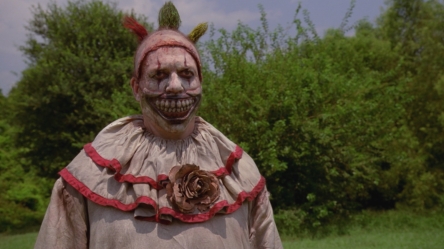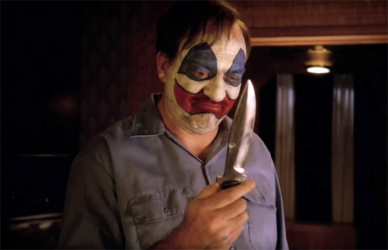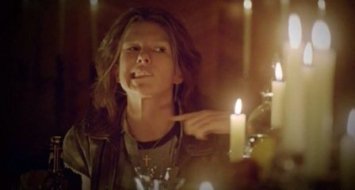I’m a fan of American Horror Story, and so far forgiven both a lot of its excesses, particularly its repetitive use of archetypes and mise-en-scene with Baz Luhrmann levels of subtlety. I’ve also been generally on board with its promiscuous use of pop culture referencing, even in places where it is simply meretricious (Elsa ‘Life on’ Mars, anyone?).
Part of the fun of the show is the reworking of horror genre staples: the amoral Nazi doctor, the killer clown, the haunted house. But these are precisely that – they are generic. The tropes are vague, which allows for innovation, reinvention, and creativity, which I think the show has in spades.

John Carroll Lynch as ‘Twisty the Clown’ from AHS: Freak Show
In Devil’s Night (S5, E4), though, the allusions become less oblique. No longer do we see pastiches of American horrors, patchworks of unspecified nightmares stitched together through expert storytelling and diverting style. This time, the evildoers are given specific names, names we recognise, names that belong to real serial killers. I found this disturbing on an uncomfortable new level.
A very quick plot summary: on Halloween night, depressed and disturbed Detective John Lowe (Wes Bentley), drinking alone at the bar of the Hotel Cortez, discovers he has been invited to a party in which all the other guests are, in fact, serial murderers of some repute. John Wayne Gacy (John Carroll Lynch, who’d already played a clown killer in AHS: Freak Show) , Richard ‘Night Stalker’ Ramirez (Anthony Ruivivar), Jeffrey Dahmer (Seth Gabel), and a still-anonymous Zodiac killer (hooded), are in attendance.
The dinner largely consists of conversing about and, in the case of Dahmer, replaying, the horrors that they meted out on their victims. Each of them also tells the story of how they first came to the Cortez. The latter tales, of course, are inventions, but they mix aspects of the biographies of these killers into the story They aren’t real, but they are plausible. Thinking about the mix of fact and fiction is, of course, a preoccupation for me, but here I’m interested in how it is managed in a show so dependent on excessive fantasy (cf Lady Gaga’s gloriously camp turn as ‘The Countess’).
The high-concept of the episode is first introduced through a drunken encounter between Lowe and a roughly dressed woman who looks (and acts) a lot like Aileen Wuornos. Lowe naturally believes her to be dressed for Halloween, complimenting her on her costume and performance. Of course there is dramatic irony here – we know that the Cortez houses ghosts and other supernatural beings. If this woman looks like a killer, and sounds like a killer and acts like a killer, chances are, she’s a killer – or the ghost of one.
I enjoyed Lily Rabe’s performance of this character. She utilised some of the tics we associate with Wuornos through her pre-existent screen representations, the Nick Broomfield documentaries, and, of course, Charlize Theron’s interpretation in Monster (2003), but she seemed to be parodying them rather than going for a straight-out impersonation. This is one of the ways in which we are distanced from these ‘real-life’ killer characters .
Another is Lowe’s skepticism, which provides an ‘out’ for the viewer (and for the producers). His insistence that these are actors, that it is impossible for them to be the real-life figures, offers a self-reflexive cue to assure you that none of this is real, so relax. The last of these comes at the end of the episode, where Lowe is assured by Sally (Sarah Paulson) that the strange and horrific events he has seen were simply Absinthe-induced hallucinations. Once again, we are reassured of the illusion of it all. Even though these representations bear traces of real-life ghouls, they don’t really exist.
Except that they do (or, did). I have issues with that trace, however faint it may be, that connects these representations to (unspeakably horrible) crimes that really happened. I understand that serial killers pass at an accelerated rate from criminal case study to infamy to myth to legend, and that there is a cult of fascination attached to them.
(This, by the way, was made awfully clear to me by looking at the YouTube comments from the teaser trailer above. In them, you can see people speculating about who can be seen at the serial killer party, with some people hoping for, then disappointed by the absence of, Ted Bundy. In fact, they call him Ted. We are on first name terms with deceased multiple murderers, apparently. Honesty impels me to admit that I have googled the names of the figures at the AHS party and read their profiles with ghoulish interest in the past, but even I draw the line at killer fandom.)
In understand all of this, but it still makes me queasy, because these were rapists, torturers, murderers with victims, whose real lives, and the lives of those around them, were destroyed. There is a disturbing lack of care for the dignity of those individuals. The subjects represented by docudrama or biopic in film and television (and their families) often have this complaint to offer – the feeling of being used, misunderstood or exploited – and it is one with which I have a great deal of sympathy.
This does not mean I believe that difficult, frightening or evil events or people should never be represented on screen. I would simply argue that there is value in respecting the humanity of the victims. No matter how much the programme uses devices like the ones discussed above to undermine its own reality claims, it still gleefully perpetuates the legend of murderers. It does so in a fantasy programme that could easily have invented cyphers for them, used the abundant imagination of its producers and writers to avoid the clash with reality. For me, this is a moral failure.



John Carroll Lynch also played the character that Jake Gyllenhall THINKS is the Zodiac killer in Zodiac so there’s a little more (still poor taste) intertextual shenanigans going on here too…
LikeLike